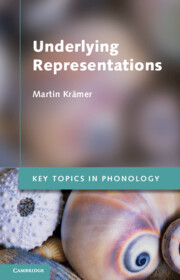Book contents
- Frontmatter
- Contents
- Acknowledgements
- Abbreviations
- 1 Getting started
- 2 Arbitrariness and opposition
- 3 Derivation and abstractness
- 4 Underspecification returns
- 5 The devil is in the detail
- 6 Psycho- and neurolinguistic evidence
- 7 On the form and contents of contrastive features
- 8 Underlying representations in Optimality Theory
- 9 Preliminary results
- Glossary
- Notes
- References
- Name index
- Language index
- Subject index
- References
7 - On the form and contents of contrastive features
Published online by Cambridge University Press: 05 November 2012
- Frontmatter
- Contents
- Acknowledgements
- Abbreviations
- 1 Getting started
- 2 Arbitrariness and opposition
- 3 Derivation and abstractness
- 4 Underspecification returns
- 5 The devil is in the detail
- 6 Psycho- and neurolinguistic evidence
- 7 On the form and contents of contrastive features
- 8 Underlying representations in Optimality Theory
- 9 Preliminary results
- Glossary
- Notes
- References
- Name index
- Language index
- Subject index
- References
Summary
[W]e have no right to attribute to the sound some value which would disagree with its nature.
(Grammont 1901: 321)INTRODUCTION
In the previous chapters it has been established that underlying representations can be fairly abstract. First, it was shown that language users make use of discrete contrastive features rather than the whole phonetic signal. Second, psycho- and neurolinguistic experiments have shown that features are underspecified in underlying representations if they are the unmarked value of a contrast or if they are redundant. In this chapter we will have a look at what is inside contrastive features. The question is whether they contain information on or instructions for their articulation or information on the acoustic/perceptual properties of segments. Alternatively, features could be abstract labels that mark segments as different from others and group them into classes.
In most contemporary feature theories the features are defined by acoustic properties of the targeted sound or by the involved articulators or articulation. Halle (1995) distinguishes articulator-bound features and articulator-free features. Among the former we find features such as [round] (lip rounding) or [labial] (involvement of/constriction of the air stream channel with the lips), the additional place features [coronal] (constriction via the corona or front part of the tongue) and [dorsal] (constriction by the back of the tongue), [ATR]/[tense] (raising or lowering of the tongue root and consequential tenseness or laxness of the tongue body) and [nasal] (air flow through the nasal cavity). Examples of the latter are [±continuant], referring to continuant or interrupted air stream, which can be interrupted at (almost) any point in the vocal tract, [±sonorant], which refers more or less to intensity and [±strident], which is defined by turbulence in the air stream, high energy at high frequencies.
Information
- Type
- Chapter
- Information
- Underlying Representations , pp. 149 - 175Publisher: Cambridge University PressPrint publication year: 2012
